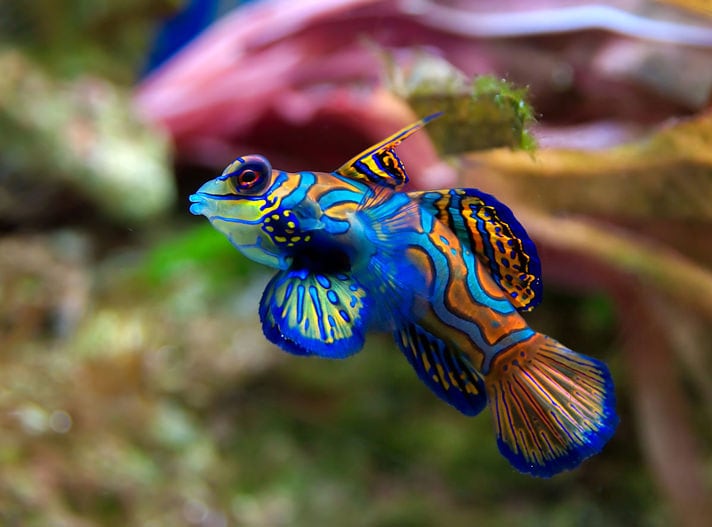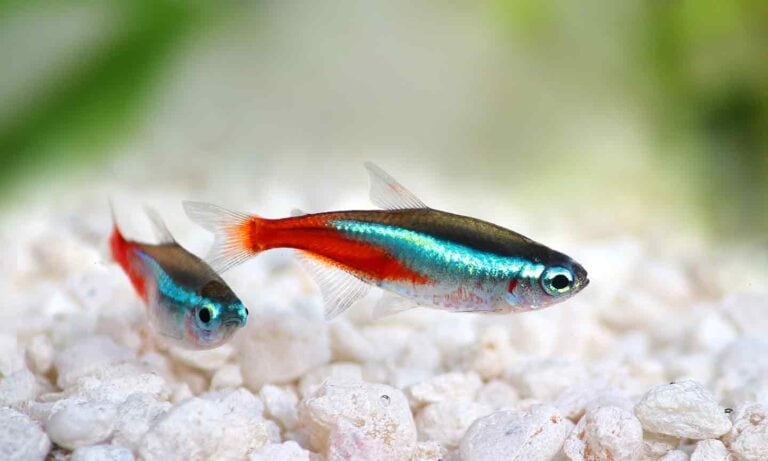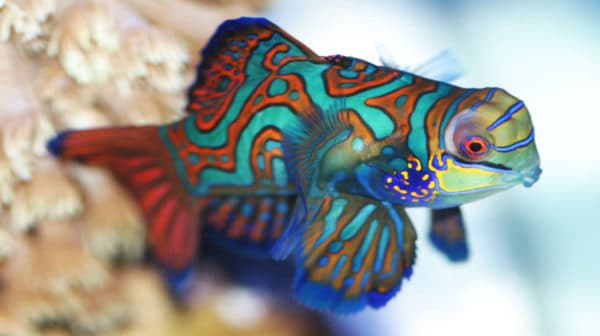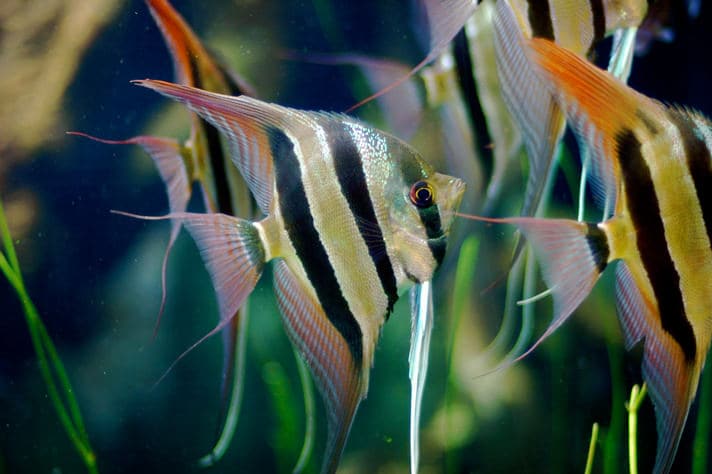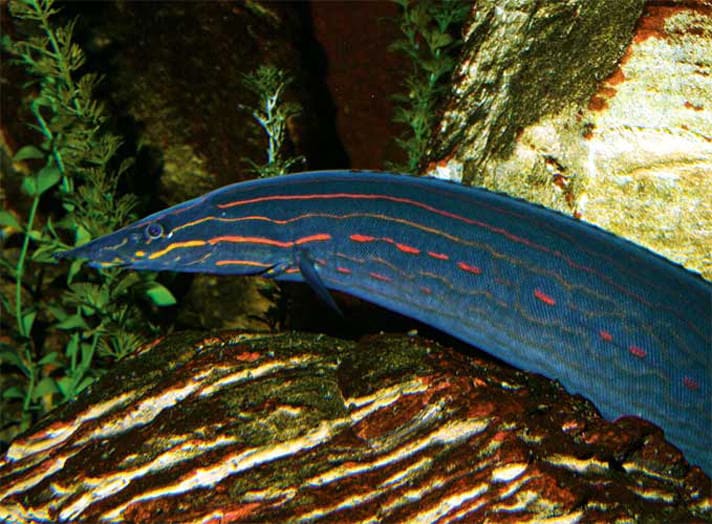“Click here for 54 recipes for mandarinfish.”
I couldn’t believe it! How could anyone be so perverse as to devise and post so many recipes on the Internet for this small gem of a fish that no sane aquarist would dream of eating? Almost immediately, however, my long-term memory cells kicked in and, in the far recesses of my mind, lay the distant recollection that there is more than one mandarinfish.
This other mandarin is only very remotely related to our beloved Synchiropus splendidus and relatives. It is, in fact, a freshwater perchlike fish known by the scientific name Siniperca chuatsi and can grow to about 11 inches and a weight of 18 pounds. It is found in the Amur River basin and in China, and it is a widely used food fish in Asia.
The Mandarin Family
The focus of this article is a group of, at most, five delightful species: “the” mandarinfish (Synchiropus splendidus), also known as the green or striped mandarin, the psychedelic fish or picturesque dragonet; the spotted mandarin (S. picturatus), also confusingly known as the spotted-green mandarinfish, psychedelic mandarinfish, psychedelic fish or picture dragonet; the circled mandarin or dragonet (S. circularis); the west Australian dragonet (S. occidentalis); and the redback dragonet (S. tudorjonesi).
In practice, only the first two species are encountered with any frequency in the hobby. However, I include the others to provide a wider picture and as a sign of what may be around the corner, especially in regard to S. circularis.
Despite this five-species window providing a slightly wider picture of aquarium mandarins, it is a limited one because there are 43 species in the genus Synchiropus, the vast majority of which have never been seen within the marine hobby and are not likely to be seen in the foreseeable future.
Together with an additional 19 genera, mandarins constitute the family Callionymidae — the dragonets — containing nearly 190 species at the time of this writing. All are marine fish, and most have an Indo-west Pacific distribution. While some live on reefs with sandy patches (including the mandarins featured in this article), many live on sandy bottoms, feeding on small, bottom-dwelling invertebrates.
The largest member of the family, the longtail dragonet (Callionymus gardineri), can grow to 12 inches in length. The smallest, the Saint Helens dragonet (C. sanctaehelenae), attains only about 0.8 inches in length. The species that form the subject of this article (S. splendidus and S. Picturatus) are around 4 inches or less in length.
Closely related to, but distinct from, the dragonet family are the slope dragonets (family Draconettidae). This is a much smaller family containing around 14 species in two genera: Centrodraco and Draconetta. These fish resemble the more streamlined dragonet relatives of Synchiropus, occur mostly on sea mounts or along the edge of the continental shelf, and are never seen in the hobby. In general appearance, mandarins also look a bit like combtooth blennies (family Bleniidae) or gobies (family Gobiidae), but fin and other skeletal features set them apart in their own family.
While we don’t have any details regarding the fossil ancestry of any of the Synchiropus species, we do know that mandarins have a long family history; fossils of Callionymus are known from early Eocene deposits. The Eocene epoch lasted 56 million to 34 million years ago.
Protective Poison
Being small, colorful, slow-moving bottom dwellers, mandarinfish would seem to be perfect sitting targets for all kinds of predators. However, their apparent vulnerability is deceptive; mandarins pack quite a big toxic punch.
Like many other fish that lack scales, mandarins secrete a thick body slime that offers a degree of physical protection and allows them to move around their natural habitat without damaging their skin. It has been suggested that the body slime also allows them to move faster through the water, but to what extent appears open to debate. More significant is that the slime offers protection against parasites and makes mandarins resistant to disease. Even more important is that the slime has a strong odor and flavor that predators find distasteful. As a result, they pass mandarins up during their search for food. It is likely that the bright colors of S. splendidus also act as a warning to potential predators that it is best left alone.
In addition to their foul odor and taste, mandarins possess sacciform (saclike) cells on their skin, which produce toxins to protect against predators. While these are closely linked to the structures that produce slime for the skin, the sacciform cells are separate.
Luckily for aquarists, mandarins are not in the habit of releasing these toxins under normal circumstances. Were this to be the case, they would not be suitable for a mixed aquarium; these secretions would put the health and the lives of delicate tankmates at risk.
It is only when the fish is placed under undue stress that the toxin is released. The level of stress that would elicit such a response would, for example, be netting and removal from the fish aquarium when transferring the fish from one tank to another. Even then, toxins are not invariably secreted, but to be on the safe side, it is best to gently guide any mandarin that needs to be transferred into a transparent container with the net (without actually trapping the fish in the mesh), lifting the container out of the aquarium and transferring the fish to its new quarters.
The Mandarin Aquarium
While mandarins are often found in small groups or pairs in the wild, males are intolerant of each other in the confines of an aquarium. This characteristic is not unique to Synchiropus; many reef fish are aggressive within aquariums but appear not to be so in nature.
In reality, many of these same fish are, indeed, aggressive toward conspecifics (members of their own species) in their natural waters. The difference is that subordinate individuals always have an escape route in the sea, and this is usually enough to ensure that aggression is not taken to extremes. This is not possible within an aquarium. When faced with a rival that doesn’t appear to flee, an aggressor will press home its attack, often to the extent that the victim will end up spending most of its time in hiding or will eventually die, either of stress or injuries.
Despite male-to-male aggression, two male mandarins may be kept in the same aquarium, but the tank has to be large enough and be sufficiently stocked with live rock or the equivalent. Your tank should allow each individual to establish its own territory, to have several easily accessible escape routes and to encounter its rival only occasionally. Most home aquariums, however, don’t fall into this category.
Spacewise, mandarins are not demanding. They are rather sedentary fish that spend much of their time during the day resting among corals or rocks or on sandy patches or hopping between rocks and corals in their search for small invertebrates. Corals, while being invertebrates, are safe from these fish, because their preferred diet consists of copepods, amphipods and the like.
Putting an actual figure on the tank size required by mandarins is a difficult task. Being sedentary, they don’t require a lot of swimming space. Therefore, the size of tank will depend on the choice of tankmates, and their space requirements, or on whether you want the aquarium to be the source of a regular supply of “pods” for the mandarins to feed on. A 30-gallon tank may suffice, depending on tankmates, but 65 gallons or more may (and I stress, may) provide an ample supply of pods.
A safer way of ensuring that there will be a constant supply of pods is to provide what is commonly referred to as a “pod pile.” This consists of a pile of rocks where pods can shelter and reproduce. The pile is fed every couple of days with frozen or fresh fish food for the pods. They will feed and reproduce in numbers, provided that the innards of the pile are inaccessible to fish and the amount of food is small enough so that it is consumed before it has a chance to rot.
An alternative approach is to connect the tank to a refugium. By definition, a refugium is a refuge where the creatures living in it are safe from predation. It consists of a tank that, while being separate from the main aquarium, is nonetheless connected with it so that there is an interchange of water between the two. Sizewise, a refugium can be as large or as small as you want, within limits, of course. For example, it is sometimes recommended that a refugium be about one-tenth the volume of the main tank. This may be reasonable with tanks containing 40 gallons or more, but once you start coming down in size, the refugium could prove to be too small to provide sufficient food for a group of mandarins.
Aquarium décor should include, as previously mentioned, lots of live rock and sandy areas, preferably in full view. Mandarins will often rest not just on the sand but partially buried in it as well.
Temperatures should be 74 to 82 degrees Fahrenheit, but take into consideration the temperature requirements of tankmates. A specific gravity range between 1.023 and 1.026 will be adequate, as will a dKH between 8 and 12. The pH should be between 8.1 and 8.4. Mandarins will tolerate readings above and below those stated, but their tankmates may not.
Filtration should not be on the vigorous side because mandarins are not strong swimmers. Ammonia and nitrite levels must, as always, be at or close to zero.
Feeding Time
In addition to setting up refugiums and providing your mandarins with access to pods, you should provide other foods.
There is no denying that mandarins are fussy and challenging feeders if they do not have a natural supply of food. Nonetheless, with patience and perseverance, many specimens can be trained to accept gut-loaded brine shrimp. These brine shrimp, with their guts full of rotifers, constitute a much more nutritious meal than brine shrimp on their own.
Generally, the live brine shrimp will, sooner or later, elicit a feeding response from the mandarins. Once they’ve acclimated to feeding on live brine shrimp for a time, thawed-out frozen mysids or other small invertebrates can be mixed in with the live shrimp until the mandarins begin to pick at this new source of food. Over time, it might prove possible to replace the live food with thawed-out alternatives.
Mandarins are slow movers that tend to pick up their food from the bottom. Turn off the filtration or aeration equipment for a few minutes during feeding to allow the fish time to “hunt down” their prey.
Enterprising aquarists have devised many methods of feeding “dead” foods to mandarins; even granulated food has been accepted with due perseverance and ingenuity. The key factor in all these ingenious techniques is the placing of the food in a clear glass container, such as a bottle, in which the neck is wide enough to allow the mandarins in and out, but too narrow to allow more aggressive feeders like tangs in.
This method has much to recommend it, as it ensures that the placid, slower mandarins don’t have their food stolen from under their noses and don’t have to compete with faster tankmates at feeding time.
Recently, matters have taken a distinct turn for the better with the introduction of commercially bred and raised Synchiropus. These fish have been reared on commercial foods and will readily take to them once settled in their new home.
Mandarin Selection
Only two species of Synchiropus are kept regularly in home aquariums. However, I am including five here because I suspect that we shall hear much more of the other three species before long. Indeed, one of these occasionally turns up in shops (often collected as a bycatch).
Synchiropus splendidus
Common Names: Mandarinfish; blue, green or striped mandarinfish; psychedelic fish; picturesque dragonet and mandarin goby (but it is not a goby).
Range: Western Pacific, from Ryuku Islands to Australia.
Size: Maximum total length is 23/4 inches, but this species is known to grow larger than this in aquariums when its needs are met.
Notes: This colorful species is widely regarded as one of the most beautiful aquarium fish. Males are intolerant of each other. Tankmates must be non-aggressive. Captive-bred stocks are available.
Synchiropus picturatus
Common Names: Spotted, spotted green and psychedelic mandarinfish; psychedelic fish; picture dragonet; green-spot mandarin goby (see above); and target-spotted dragonet.
Range: Indo-west Pacific, from the Philippines to eastern Indonesia and northwest Australia.
Size: Total length is 23/4 inches, but larger aquarium size is often reported.
Notes: Along with S. splendidus, this is one of only two fish reported to exhibit blue coloration, but it contains fewer blue areas than its relative. Tankmates must be non-aggressive. Body base color is green. Some captive-bred stocks are available.
Synchiropus circularis
Common Names: Circled or circular mandarin ?or dragonet.
Range: Western Pacific. Reported from the Mariana and Chesterfield Islands, and recently, from the Philippines.
Size: Maximum length so far reported is slightly less than 1 inch.
Notes: This species is only rarely seen and, as far as I am aware, is never intentionally targeted by collectors. It is a beautiful little fish, looking very much like its above relatives, and has a brownish base body color. Few details are available about this species.
Synchiropus occidentalis
Common Name: West Australia dragonet.
Range: West Australia.
Size: No exact details are known, but it is probably the same as S. splendidus.
Notes: Considered by some to be a synonym of S. picturatus but as being a distinct species by others. Rarely seen. Possesses blue coloration, which may have similar origin as in S. splendidus and S. picturatus. One for the future. Not available in the hobby at this time.
Synchiropus tuderjonesi
Common Name: Redback dragonet.
Range: Indonesia, Cenderawasih Bay (in Papua, New Guinea). Also reported in Bali.
Size: No details available.
Notes: Incredibly beautiful, vivid-red coloration with dark patches. Described in January 2012 by Allen and Erdemann. No details of aquarium care available but probably similar to other mandarins. As far as I am aware, this species and its closest relatives, S. moyeri and S. morrisoni, have not yet been seen in the trade, not even as accidental “bycatch” imports. Another one for the future.
Although many other vertebrates also possess blue coloration, these mandarins generate their color not by what is termed as thin-film interference from piles of flat, thin and reflecting crystals but through blue cellular pigment, produced within specialized intra-cellular structures (organelles) referred to as cyanophores.
Breeding these rainbow-colored fish has been achieved in home aquariums but not regularly. However, reports of successful breeding continue to appear (including videos of egg and sperm release) on the Internet. What was once an extremely rare occurrence — and still isn’t commonplace — may well become less an isolated event with the passage of time.
Assuming that the fish are feeding well and are relaxed in their tank, females may begin to fill up with eggs and males may become more active than usual (especially in the evenings) as they seek out the females. If everything goes well, a pair will line up their bodies alongside each other, swim away from the substrate, release eggs and sperm, and swim back to the bottom. After all the eggs (around 200) have been released, the pair return to their normal activities and the eggs are left to float unattended. Spawning may be repeated weekly, or even more frequently, over a period of several months.
Hatching is very rapid — around 15 hours, or even less — but it will take four days before the fry start feeding on the smallest of foods, like rotifers or “green” water (water loaded with phytoplankton). This phase in the young mandarins’ life is particularly difficult but not impossible to tackle. The main, but not only, challenge is getting them to feed, but given that they are so small, this in itself presents a challenge, not just with regard to mandarins, but to other marines as well.
Space limits me to mentioning only the briefest details here. Interested readers should search the Web, articles and books, and communicate with other mandarin fans for more information on breeding and rearing.
If you rear your own mandarins and then maintain them successfully, you can look forward to many years of enjoyment with them. Up to quite recently, we could only expect to keep mandarins alive in our aquariums for two to four years, but improving technology, husbandry methods, foods and knowledge mean that we are getting closer to the natural 10- to 15-year life span of these gorgeous, fascinating jewels.
Take the Challenge
Mandarins are not a beginner fish by any means, but for the dedicated aquarist who is up to the challenge, these gorgeous gems are worth the effort.
Author John Dawes is an internationally renowned authority on fish, aquariums, ponds and water gardening. Formerly a teacher and then a lecturer at the University of Bath, England, he has, since 1983, been a freelance author, editor and international ornamental aquatic industry consultant. His books have been published all over the world. John holds a joint honors degree in biology and geology and a certificate in education. He is also a fellow of the Zoological Society of London and The Linnean Society of London, a member of the Society of Biology (London) and a chartered biologist.
Posted By: Chewy Editorial
Featured Image: Via fenkieandreas/Shutterstock
Share:
